Tin Whisker Electrical Short Circuit Characteristics ... - NEPP - Nasa
Tin Whisker Electrical Short Circuit Characteristics ... - NEPP - Nasa
Tin Whisker Electrical Short Circuit Characteristics ... - NEPP - Nasa
Create successful ePaper yourself
Turn your PDF publications into a flip-book with our unique Google optimized e-Paper software.
44 IEEE TRANSACTIONS ON ELECTRONICS PACKAGING MANUFACTURING, VOL. 32, NO. 1, JANUARY 2009<br />
Fig. 7. <strong>Tin</strong> whisker No. 137 graph of current versus time from the second<br />
experiment.<br />
Fig. 8. <strong>Tin</strong> whisker No. 137 graph of voltage versus time from the second<br />
experiment.<br />
IV. EXPERIMENTAL RESULTS<br />
A. <strong>Tin</strong> <strong>Whisker</strong> Breakdown Voltage<br />
The point at which a short occurs, when the film resistance<br />
breaks down, can easily be seen in Fig. 7 when the current<br />
jumps from near zero, the nanoamp range, to the milliamp range.<br />
Prior to breakdown the majority of the voltage drop is across<br />
the whisker due to the high resistance of the oxide film on the<br />
whisker. In this state, the whisker voltage reading tracks close to<br />
the power supply voltage. The power supply voltage increases<br />
linearly from 0 to 45 Vdc, then it remains at 45 Vdc for a few<br />
seconds at the end of the run until the software is given a stop<br />
command. After the film has broken down, the majority of the<br />
voltage drop is across the current limiting resistor. In this state,<br />
the low whisker voltage reading was determined by the small<br />
resistance of the whisker, card guide and micromanipulator as<br />
shown in Fig. 8.<br />
The voltage level at the transition to metallic conduction current<br />
is the voltage level at which the film and oxide layers break<br />
down. Reference Fig. 8. As in the first experiment, the graphs<br />
of voltage and current data showed single transitions, multiple<br />
transitions, and multiple transitions with intermittent contact.<br />
Fig. 9. Breakdown voltage individual value plot.<br />
The breakdown voltage for each of the 200 tin whiskers is displayed<br />
in Fig. 9. The breakdown voltage for each of the whiskers<br />
was selected first by visual review of the graphs as was done in<br />
the first experiment. To ensure that a more consistent approach<br />
was used in the data collection process in the second experiment,<br />
a computer-based method for selecting the breakdown voltage<br />
was developed using Microsoft Excel. All 200 breakdown voltages<br />
were verified using both methods.<br />
Since whiskers number 49 and 56 did not breakdown in the<br />
0 to 45 Vdc range used in this experiment, these two data points<br />
are considered censored. Minitab [9] was used in the second experiment<br />
because it contained a feature to easily accommodate<br />
censored data.<br />
B. Data Analysis<br />
The individual value plot shown in Fig. 9 provides insight<br />
into the data. The majority of the breakdown voltage values fall<br />
between 0 and 10 Vdc. The aforementioned figure shows tin<br />
whisker breakdown voltages versus card guide side where<br />
top and bottom, card guide, and LRU serial number. The<br />
right skewed nature of the data is evident from this plot. The<br />
individual values are shown in red.<br />
By default, Minitab explores the following 11 distributions<br />
for the best fit: Weibull, Lognormal, Exponential, Loglogistic,<br />
3-Parameter Weibull, 3-Parameter Lognormal, 2-Parameter<br />
Exponential, 3-Parameter Loglogistic, Smallest Extreme Value,<br />
Normal, and Logistic.<br />
In the first experiment, we used the Probability–Probability<br />
(P–P) plots along with the Kolmogorov–Smirnov test<br />
to determine the best fitting distribution. Since Minitab does<br />
not perform the Kolmogorov–Smirnov test, the adjusted Anderson–Darling<br />
test and correlation coefficient were used in<br />
its place, in addition to the P–P plots [4]. The adjusted Anderson–Darling<br />
test measures the area between the fitted line<br />
(based on chosen model) and the nonparametric step function<br />
(based on the plot points) [10].<br />
The correlation coefficient reported for each graph (distribution)<br />
measures the correlation between the data and what would<br />
be expected if the data comes from the specified distribution<br />
(represented by a line). If the data and the line are perfectly correlated,<br />
the correlation coefficient would be 1, and that would<br />
Authorized licensed use limited to: University of Maryland College Park. Downloaded on January 12, 2009 at 16:34 from IEEE Xplore. Restrictions apply.






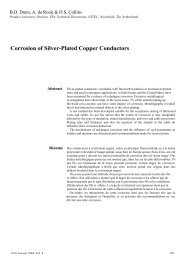
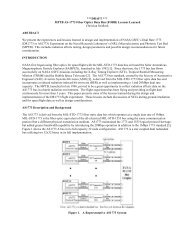

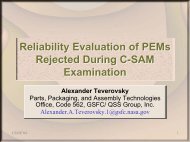
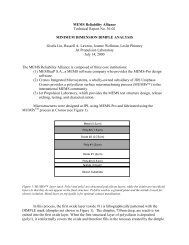
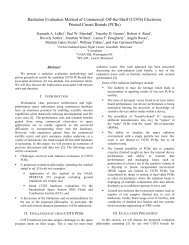




![mil-std-2223 [test methods for insulated electric wire] - NEPP](https://img.yumpu.com/4036001/1/190x249/mil-std-2223-test-methods-for-insulated-electric-wire-nepp.jpg?quality=85)